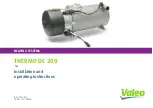
SECTION 5
TROUBLESHOOTING
21
The cause of control malfunctions can be found by
referring to the sequence of operations and electrical
schematic diagram (Figure 5-1) and checking the vari-
ous components. A volt-ohmmeter will be necessary for
some of these checks.
Voltages in plasma cutting equipment are high
enough to cause serious injury or possibly death. Be
particularly careful around equipment when the cov-
ers are removed.
NOTE
Before checking voltages in the circuit, disconnect the
power from the high frequency generator to avoid dam-
aging your voltmeter.
5.1TROUBLESHOOTING
ELECTRIC SHOCK CAN KILL! Be sure that all pri-
mary power to the machine has been externally
disconnected. Open the line (wall) disconnect switch
or circuit breaker before attempting inspection or
work inside of the power source.
Check the problem against the symptoms in the follow-
ing troubleshooting guide. The remedy may be quite
simple. If the cause cannot be quickly located, shut off
the input power, open up the unit, and perform a simple
visual inspection of all the components and wiring.
Check for secure terminal connections, loose or burned
wiring or components, bulged or leaking capacitors, or
any other sign of damage or discoloration.
5.2TROUBLESHOOTING GUIDE
A. Power Light (PL1) does not come on.
1. Visually inspect the machine for any damage.
2. Check if the cooling fan is running. If not, then check the following :
a. Check if the machine power cord is plugged to the input power receptacle.
b. Measure the input power at the receptacle. If not present, then check the wall
disconnect switch and its fuses.
c. Check Fuse (F1). If fuse is ok, then check the input circuit breaker (CB1) for proper operation. Re-
place if defective.
3. If above items check OK , the problem is internal. Send unit to an Authorized Repair Station for repair.
a. If the cooling fan is running, then measure voltage between pins P2-11 and P2-14of the control
board (should be 115 VAC). If there is no voltage, then replace transformer T2.
b. If the voltage is present, then the pilot light may be burnt out.
B. No Air Flow
A. Check air inlet supply. Unit requires 320 CFH at 65 psig.
B. Check air hose and connections. Tighten if leaking.
C. Does air flow when air test switch is in test position?
a. If not, check torch consumables, replace if necessary.
b. If above items check OK , the problem is internal. Take unit to an Authorized Repair Station for repair.
Summary of Contents for PCM-875
Page 29: ...28 D 36587 Figure 5 1 Schematic Diagram PCM 875 208 230 V 50 60 Hz 1 or 3 Phase ...
Page 30: ...29 D 36595 Figure 5 2 Wiring Diagram Sheet 1 of 2 PCM 875 208 230 V 50 60 Hz 1 or 3 Phase ...
Page 31: ...30 Figure 5 3 Wiring Diagram Sheet 2 of 2 PCM 875 208 230 V 50 60 Hz 1 or 3 Phase D 36595 ...
Page 32: ...31 D 36597 B Figure 5 4 Schematic Diagram PCM 875 400 460 V 50 60 Hz 3 Phase 1 2 3 4 5 6 ...
Page 33: ...32 D 36598 Figure 5 5 Wiring Diagram Sheet 1 of 2 PCM 875 400 460 V 50 60 Hz 3 Phase ...
Page 34: ...33 D 36598 Figure 5 6 Wiring Diagram Sheet 2 of 2 PCM 875 400 460 V 50 60 Hz 3 Phase ...
Page 35: ...34 D 36715 A Figure 5 7 Schematic Diagram PCM 875 575 V 60 Hz 3 Phase ...
Page 36: ...35 D 36716 Figure 5 8 Wiring Diagram Sheet 1 of 2 PCM 875 575 V 60 Hz 3 Phase ...
Page 37: ...36 D 36716 Figure 5 9 Wiring Diagram Sheet 2 of 2 PCM 875 575 V 60 Hz 3 Phase ...
Page 47: ...46 ...
















































